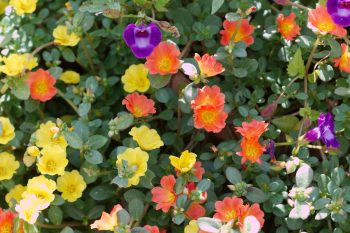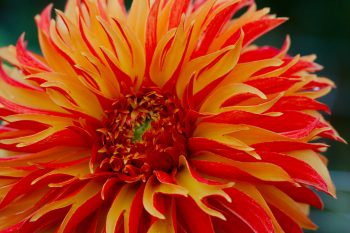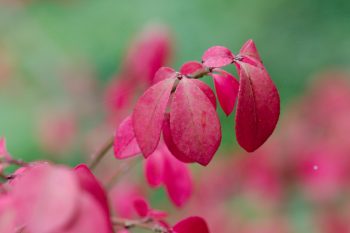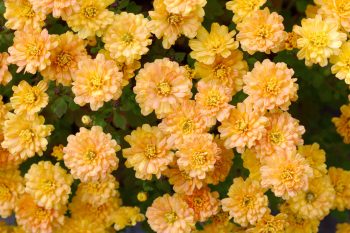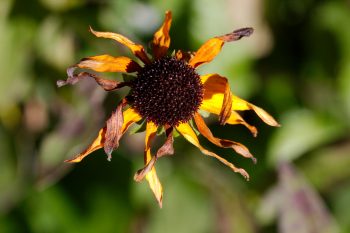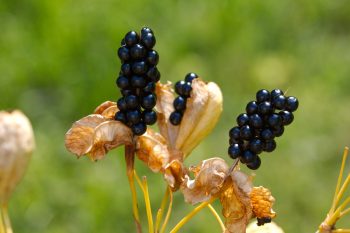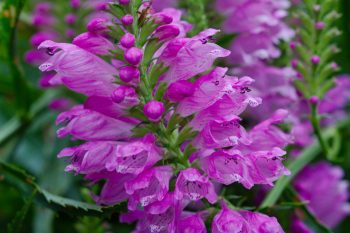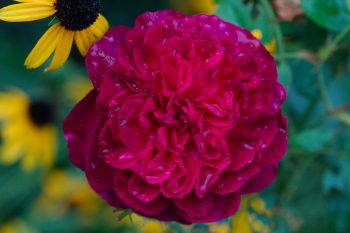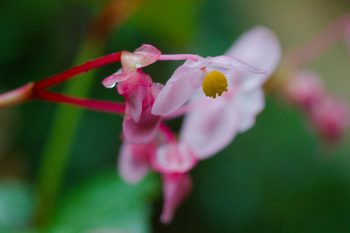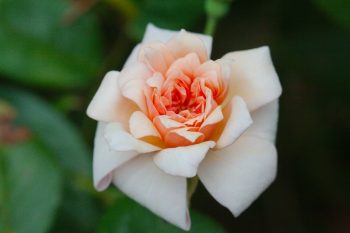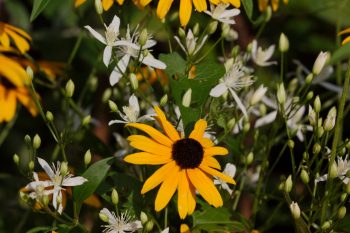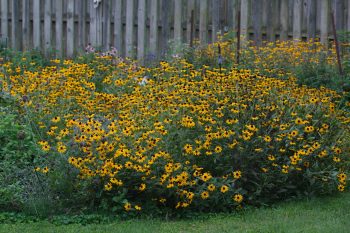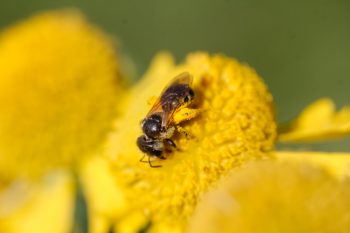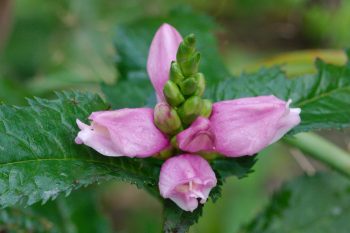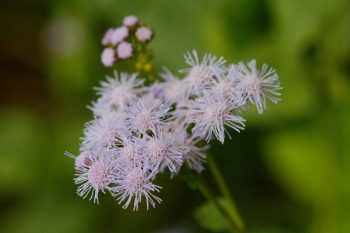Common purslane (Portulaca oleracea) is a noxious weed where it is warm enough for it to survive through the winter. Here it is grown as an annual and it’s the large-flowered cultivars that are grown here, specifically for their flowers, which are present pretty much all summer. The flowers are generally open in the morning and then close up when the day gets hot, but on an overcast day they might stay open all day. Their colors are really something and we’ve loved having them outside our kitchen door this year. In case you’re wondering (I was, so I asked Cathy), the purple flower is Torenia fournieri, commonly known as wishbone flower, an annual that has also done exceptionally well this year.
Flowers and Plants
Yellow and Orange Purslane
Laciniated, Bi-color Dahlia
Cathy and I went to the Dahlia garden at the county’s Agricultural Farm Park this afternoon. I think I’ve found my absolute favorite dahlia of all time. I love dahlias in all their forms and wouldn’t really disparage any of them. That being said, I’ve always been more drawn to the single and mignon classes of dahlias more than the huge dinner plate or cactus classes. This one, however, I really, really like. It’s a laciniated or fimbriated dahlia, characterized by having petals that are split at the end into two or more divisions. Added to that, this one has petals that are a different shade on the front from the back. I particularly like the color combination of orange on the front and almost red on the back. It’s a pretty large bloom, as well and the flowers are absolutely lovely. So, for now, it’s my favorite.
Burning Bush (Euonymus alatus)
As a landscape plant, burning bush (Euonymus alatus) can be quite striking. I hesitate to ever recommend it. It is an invasive and its use is actively discouraged in many areas (and even banned in Massachusetts, I believe). It’s a native of northeastern Asia and is naturalized over much of eastern North America. The plant we have is in a pot, which helps keep it small, although I’m not really sure I want even that much in my yard. Not that getting rid of ours is going to make much difference, as this is grown all over our area and the cat is already out of the bag.
Chrysanthemum
This is an unnamed chrysanthemum that Cathy bought last year for her mom’s birthday. We basically did nothing with it since then but it’s come back wonderfully this fall. It’s not quite pure yellow, with a bit of orange in its petals, and a very nice bunch of flowers it really is. We’ve often grown mums and asters but never really more than one or two. This year, in addition to this chrysanthemum in a hanging basket, we have an aster called ‘October Skies’ that we planted in our large, central bed in the back yard. I suspect I’ll post a photo of that before too long, as it’s coming into bloom, as well.
Rudbekia
The black-eyed Susans in our yard are mostly done. There is a bit of yellow left in spots but for the most part, the petals (technically they are ‘ray flowers’) are brown or at least a deeper, burnt orange color, or have fallen off completely. We generally leave the seed heads for the birds. The gold finches, in particular, seem to like them. I personally like the colors of the fading blooms. Naturally the bright, orange or mid-summer is really impressive, especially with them in such numbers. But the more subdued colors of fall are, to me, more appealing.
Ageratina altissima (White Snakeroot)
This is a weed and we pull it up but it’s actually fairly attractive. It’s called white snakeroot (Ageratina altissima) and it’s a fairly common native plant in our area. It’s similar to the blue mistflower (Conoclinium coelestinum) that we have in some of our borders but quite a bit taller (it’s three or four feet tall, compared to about about a foot and a half). This one is behind some shrubs so managed to get pretty much full grown before I noticed it. It will be gone shortly but I thought I’d take some pictures, anyway.
Honey Bee on Aster
Cathy and I took a walk along Croyden Creek early this afternoon. It has turned cool, although with the humidity in the woods and the steep nature of the trail, I was fairly warm. It was nice to get out, of course, and we only saw a few other people. We walked from the Croyden Creek Nature Center down stream almost to where it joins Rock Creek. Coming back, we turned up a side valley and came out between the two main parts of Rockville Cemetery. Back and the nature center, I took this photo of a western honey bee (Apis mellifera) on an aster of some sort.
Iris domestica (Blackberry Lily)
Native to the Himalayas and the Russian far east, the blackberry lily (Iris domestica, formerly known as Belamcanda chinensis), is a lovely and well behaved herbaceous perennial. It self-seeds pretty well and we promote that by distributing the seeds fairly widely. We’re getting to the point where we might actually pull a few up if they aren’t where we want them, but generally we let them go wherever they come up. They have wonderful, bright orange flowers in succession during the early summer and then the fruit ripens in pods that open up to reveal the “blackberries” that give the plant its common name.
Physostegia virginiana
We have a patch of Physostegia virginiana (obedient plant) in the back border. This area of the garden was one of the worst in terms of being out of control and we did a lot of digging there this year. Cathy did most of it, although I did help a bit with some of the deeper digging. It was overrun with goldenrod (Solidago) and mugwort (Artemisia vulgaris), which we wanted to get rid of completely, but even the things we grew on purpose, like the Monarda and this Physostegia, were out of control and needed to be thinned out. So, we still have this, but less than we did. It’s a fairly aggressive perennial, spreading by both rhizomes and by self-seeding. So, grow with caution.
Passiflora alata ‘Ruby Glow’
Cathy and I went to Brookside Gardens this afternoon. It was really nice to be out in such a lovely place. There were quite a few people there but it wasn’t as crowded as I sort of expected it to be. We generally go in late winter and then early spring and I don’t remember when we’ve been at this time of year (if we even have). There was a lot to see and we enjoyed it very much. I got a few rose names that I’m going to look for, as well. This is a passion flower (Passiflora alata) called ‘Ruby Glow’
Rose ‘Munstead Wood’
It rained today and I didn’t really get to go out until pretty late. The water on this rose, (the David Austin rose ‘Munstead Wood’) was pretty so I took a few pictures of that. This rose was only planted this spring and it’s doing quite well. The flowers are now up above the top of the hardware cloth fence that I put around it to keep the rabbits off. The flowers are now blooming just below the level of the black-eyed Susans and soon they will be above them. I’m really looking forward to the display we get from this next year.
Fall Flowers
I suppose you could say these are late summer flowers, rather than fall flowers, but there’s no hard line between summer and fall. The black-eyed Susans are summer flowers and are just finishing up. There are still quite a few of them blooming but not nearly so many as there were. The autumn clematis (Clematis terniflora) is just about in full bloom, as is the blue mistflower (Conoclinium coelestinum). The blackberry lily (Iris domestica), which blooms in early summer, is nearly in seed. All together, it makes a pretty nice combination of colors and textures.
Christmas Fern (Polystichum acrostichoides)
Cathy and I took a walk on the west side of Lake Frank after work today. The heavy rain we had yesterday meant that the water level was high, but the trail wasn’t too muddy. We enjoyed being in the woods, hearing the birds, frogs, and insects, and being away from traffic and people. We saw large patches of partridge berry (Mitchella repens), which we hadn’t notice there before. Today’s photo, though, is of the ubiquitous Christmas fern (Polystichum acrostichoides), a common perennial in our woods.
Begonia grandis (Hardy Begonia)
I had a picture of the leaves of this Hardy Begonia (Begonia grandis) earlier this month. Now it’s in bloom and adding a little brightness to the shady spot outside our front door. It’s a great plant to have and looks like it shouldn’t be sturdy enough to survive our winters but it does and it actually does quite well. It won’t grow well too far to our south because of the heat of summer or too far to the north because of the cold winters, but here it’s quite reliable. Highly recommended.
Rose ‘Perle d’Or’
I’ve posted photos of this rose before but it deserves to be shown a few times each year. It’s a small China rose called ‘Perle d’Or’, bred by Joseph Rambaux in 1884. It has a wonderful, fairly strong fragrance that sits in the air outside our front door (where the rose is) and we are often treated to is as we go out or come in. I don’t think it’s been without at least a few blooms since it started in May. Some years it’s hurt by a particularly cold spell but we’ve had relatively mild winters the last couple years so it’s doing particularly well now.
Early Autumn
The autumn clematis (Clematis terniflora) is coming into bloom. This is a fairly aggressive vine native to Japan. It can be a little invasive but if you have a largish area to cover, it’s not a terrible choice. It’s flowers are a lovely white and come late in the summer and continue well into the fall. One of it’s common names is sweet autumn virginsbower. We have it growing on the falling down fence at the southwest corner of our house (the southeast corner of our back yard). Cathy is especially fond of it and as long as I’m allowed to keep if confined to that area, I’m happy to let her have some.
The Back Garden
This is a portion of our back garden, which, as you can see, is somewhat dominated by black-eyed Susan flowers at this time of year. They are probably just past their peak but will provide color for a bit longer as they fade from their bright orange to a more rusty, autumnal ochre. You can just make out the hardware cloth ‘fence’ around one of my roses a little to the left of center. By the end of the summer, the three roses should be tall enough that they are safe from rabbits, although there’s not really anything we can do about deer.
Pollinator
This little bee is absolutely loaded with pollen. (Side question: if pollen is spelled with an ‘e’, why does pollinator have an ‘i’ in its place?) Anyway, Cathy and I went to Meadowside Nature Center this afternoon and walked around a pond and through the woods. In addition to this little bee, I got a pretty good photo of a common whitetail (Plathemis lydia), a fairly common dragonfly. But I thought I’d go with the bright yellow of this photo instead. I’m also partial to bees, of course.
Chelone lyonii (Pink Turtlehead)
We’ve only had this native perennial a few years and this is by far the best it’s done in our garden. We have it in a somewhat shady area. Over time it should spread and form a clump, although not so much that it could be considered invasive (like much of what we have). The snapdragon-like flowers are fairly large and as you can see, they are borne in tight, spike-like terminal racemes. They are actually native to a bit further south than we are but have become naturalized over much of the east coast.
Conoclinium coelestinum (Blue Mistflower)
We picked up some blue mistflower (Conoclinium coelestinum) along with some other plants that were being given to us. It’s spread around the yard and now we have both the normal pale blue, as seen here (it’s more blue than this photo makes it look) and a white sport (or perhaps the blue is the sport). It blooms late in the summer, just starting now, and will be around into the fall. I don’t know that I’d run out an buy any, but it’s not bad to have a late summer bloomer in the garden. The skippers tend to be the most common pollinators on it, but the bees go to it some, too.

